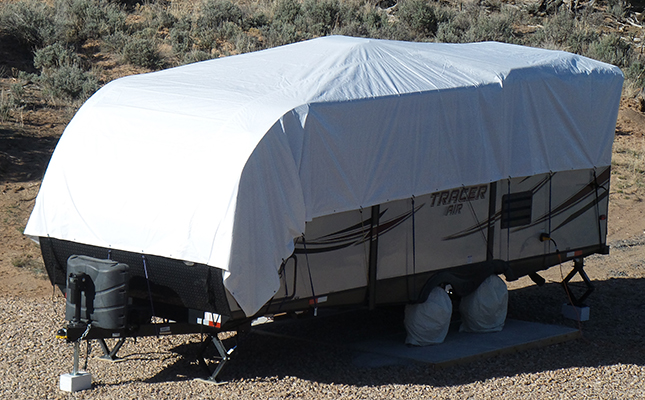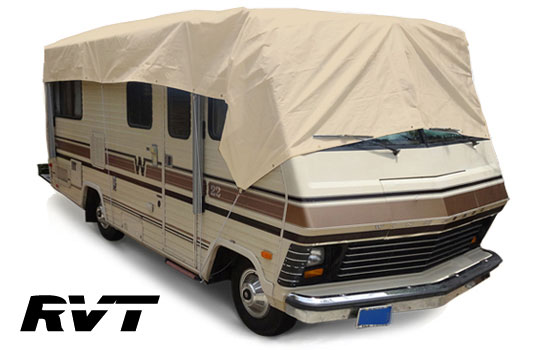Your RV goes through a lot whether it’s parked in your driveway or out on a road trip, your motorhome is constantly exposed to harsh weather, UV rays, falling debris, bird droppings, tree sap, and more. And the part that takes the most damage? The roof.
That’s why smart RV owners are choosing to protect their investment with a dedicated RV roof cover. It’s one of the easiest, most affordable ways to extend the life of your rig without wrapping the entire thing in a full cover.

In this blog, we’ll break down why it is a game-changer, how it protects the most vulnerable parts of your RV (including the windshield), and what to look for when choosing one. Whether you’re a weekend warrior or a full-time RVer, this is a read worth sticking around for.
Why the RV Roof Takes a Beating
When you’re driving or parked, the roof is the part that’s always exposed. Rain, sun, snow, ice, hail, the roof catches it first. And when you’re not using your RV? It still sits there, day after day, absorbing damage from above. Here are the top threats to your RV roof:
- UV rays that cause cracking and fading
- Heavy rain that leads to water pooling and potential leaks
- Snow and ice that add weight and encourage moisture buildup
- Tree sap, leaves, and bird droppings that eat away at the surface
- Hail or falling branches that can cause dents or punctures
Now, imagine dealing with a cracked roof or a leaky seal in the middle of a road trip. It’s not fun, trust us. This is why investing in a roof-only RV cover just makes sense.
What Is an RV Roof Cover?
It is a specially designed cover that shields only the roof and windshield of your RV, not the entire body. It’s lighter, easier to put on, and more convenient than a full-body cover. There are a few types out there, including the increasingly popular portable RV roof cover which is perfect if you want something easy to install, remove, and take on the go.
Why Choose RV Covers for Roof Only?
You might be wondering: Why not just use a full RV cover? Why go for a roof-only version? Here’s why roof-only covers are actually the smarter choice for many RV owners:
Less Hassle, More Coverage
Full covers can be bulky, heavy, and annoying to handle. You often need two people, a ladder, and a lot of patience. However, when it comes to roof-only covers, you can install them solo in minutes. And since most of the sun and water damage hits the top, you’re still protecting the part that matters most.
Windshield Protection
Some roof covers also extend down far enough to protect your windshield. That’s a big deal because windshield glass is expensive to replace and vulnerable to sun exposure and hail damage.
Portable and Travel-Friendly
A portable RV roof cover folds up small and is easy to store. You can take it with you on the road and use it at campsites, RV parks, or when storing your rig long-term. It’s not just for off-season storage, it’s useful year-round.
Lower Cost
A high-quality roof-only cover can cost significantly less than a full-body cover, while still offering 80-90% of the protection. That’s just smart budgeting.
Improves Longevity of Your RV
By shielding the roof and windshield, you prevent costly damage that leads to expensive repairs, seal replacements, or even structural problems down the line.
Key Benefits of Using an RV Roof Cover
Protects Roof Seals and Vents
Your roof is home to vents, skylights, antennas, and AC units, all of which have seals that can wear out fast when exposed to sun and rain. A roof cover keeps them shaded and dry.
Reduces Interior Heat
If you have ever stepped inside your RV and felt like you were walking into an oven, a roof cover blocks direct sunlight, helping keep interior temps lower. This protects electronics, furniture, and flooring from heat damage.

Prevents Water Pooling
Many modern RV covers for roof only are designed with a slight slope to prevent water from collecting. That means less chance of standing water turning into a leak.
Blocks Debris and Bird Droppings
A dedicated cover creates a barrier between your RV and the gunk, like leaves, twigs, pine needles, sap, and poop from above. All of this can stain or damage your roof.
Easy to Use
Most RV roof covers are lightweight and come with secure straps or clips, making them easy to install even if you’re solo.
How to Choose the Right RV Roof Cover
Here’s what to look for:
- Material Quality: Look for weatherproof, UV-resistant fabrics like polyester, vinyl, or heavy-duty polypropylene. These materials handle sun, snow, and rain without breaking down.
- Size & Fit: Choose a size that fits your RV’s roof snugly. Too loose and it flaps in the wind and if it’s too tight, it’s a struggle to get on. Measure your RV’s roof (length and width) and check the manufacturer’s size guide.
- Ventilation: Some roof covers include vents to allow moisture to escape. This helps prevent mold and mildew buildup underneath.
- Portability: If you plan on using it while traveling, get a portable RV roof cover that folds down small and comes with a storage bag. Lightweight options are best for on-the-go protection.
- Secure Fastening System: Avoid cheap covers with basic drawstrings. Go for something with adjustable straps, buckles, or elastic hems to ensure it stays put even in high winds.
Pro Tips for Making Your RV Roof Cover Last
- Clean your roof before covering it. Don’t trap dirt, sap, or moisture under the cover.
- Use a cover support system if yours doesn’t naturally slope. This helps prevent water pooling.
- Dry it before storing it. You are risking mold if you are not dying it properly.
- Make sure to check it monthly if your RV is in long-term storage. Adjust straps, shake off debris, and make sure it’s holding up.
Final Thoughts
If you’re serious about protecting your RV, you don’t always need to go all-in with a full body cover. A simple, smart, and well-made RV roof cover can do most of the heavy lifting and save you money in the long run.
Whether you’re parked at home, stored at a site, or taking weekend getaways, RV covers for the roof only give you just the right amount of protection without the hassle. And because it is portable, you’re always ready for the next weather surprise, no matter where you are.
